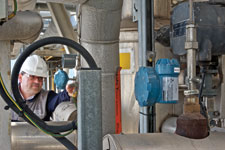

Industrial wireless communications for sensor data and plant information is now available, proven on-site, and built into internationally accepted standards. Wireless links should now be seen as just another family of techniques for the plant manager or engineer to consider alongside 4-20 mA loops, fieldbus networks and data links. Most would accept that plant data can be ‘monitored’ over wireless as effectively as from these other networks: but the action resulting from the monitoring creates a control loop.
To those who say that wireless links should never be used within control loops, it is appropriate to remind them that sludge blanket levels on settlement tanks have been monitored, and the data transmitted over a wireless link to control the de-sludging operations, for well over 30 years. Add to that a comment about the latest North Sea offshore gas platforms, where fire and gas shutdown systems are now offered by Yokogawa, using wireless gas detectors, with a dual redundant wireless network to transmit all crucial alarm data back to the logic system, alongside sensor health and battery status information.
So how else can the phrase ‘wireless sensor network’ cause a misapprehension?
That Internet hype and process plants?
The adoption of wireless as a plant tool has probably even been held back by the apparent hype and emphasis on the Internet, the ‘Internet of Things’, and ‘Big data’ networks monitoring lots of sensors – sensors everywhere. Financial directors suddenly see enormous expenditure, hundreds of $1000 sensors, mushrooming recruitment for expanded IT departments – and then they pick up the latest management articles forecasting major impacts from hacking and data breaches. No wonder they are sceptical even before starting to read a proposal.
From reports about many of the application examples quoted by enthusiastic suppliers over the last few years, it appears that success in the application of a wireless based system has come to plant engineers who had a specific and defined requirement, a problem for which the engineer’s assessment showed that a wireless system provided the most logical and cost effective answer. But then, would you expect anything less from an engineer? The typical number of wireless sensors installed initially might be quite low, say a dozen or less: usually the cost justification is based on the problems of new wiring to these extra sensors on an existing plant.
Plant networks from the major suppliers
Inevitably in this competitive field, with many vested interests, it is difficult to find a non-partisan authoritative spokesman: so Ted Masters, president and CEO of the HART Communications Foundation, says (in a video shown on the Emerson website, entitled WirelessHART: An Executive Perspective) “WirelessHART gives users the opportunity to bring in valuable data that can be used in systems to help decision support, particularly in plants that are already installed and wired. Now, the ability to put a point anywhere and bring it easily into the system, will ultimately yield better performing plants for users.”
The video also features Peter Zornio, chief strategic officer from Emerson Process Management, who paints their stance as totally devoted to ‘pervasive sensors’, i.e. sensors everywhere, monitoring the standard process plant parameters, but also gas leaks, steam leaks, corrosion/erosion, vibration, flames and valve activation, for example on safety showers. This is logical, from a sensor manufacturing company: Emerson has been collecting a whole range of new sensors to create a family of, typically, add-on plant monitoring sensors. The clue then is in the name, WirelessHART: the network provides all the data you would get from a 4-20 mA HART sensor, plus the battery status in the ‘wireless’ sensor. Other suppliers have joined Emerson as WirelessHART enthusiasts and promoters: these are mainly from the wired-HART sensor manufacturers – like Endress+Hauser, Pepperl+Fuchs – but also include ABB and Siemens.
The ISA100 viewpoint
The alternative wireless sensor data network for process plants, primarily on offer from Yokogawa and Honeywell Process Solutions, is built according to the ISA100 US standard. Suffice it to say that the ISA100 and WirelessHART systems are incompatible, but very much the same as each other, same operating frequency 2400 MHz and similar principles of networking between sensors. Yokogawa concentrate on collecting process sensor information, in the same way as WirelessHART, and have made their ISA100 sensor interface electronics available for any other manufacturer who wishes to incorporate it into its own sensors.
ISA100 has additional capabilities, in that systems can be configured to have a defined time response, and the network messaging can also ‘package’ up electronic message data from the sensor, transmit it over the network, and reconstitute it in the original format at the control room end. So this is useful for sending rotating equipment vibration signatures and other waveforms from sensor systems, for analysis by proprietary electronic units. Yokogawa has advanced this so that it can attach an ISA100 transmitter to a standard HART sensor, even power it from their wireless transmitter battery if needed, and send the HART data back over the ISA100 system: a similar RS-485 Modbus unit is also planned.
The Honeywell approach does seem to be defined by its wireless product family tradename: OneWireless. It presents a wireless network infrastructure for a process plant that can deal with all potential requirements, using ISA100 for sensors, WiFi systems for on plant access and control by laptop type systems, phones and tablets, and the capability to incorporate security cameras and video streaming from engineer’s devices.
After understanding all this diversity, the whole lot, WirelessHART, ISA100, WiFi and video transmission, all seems to go through on-site wireless access points and aerials that use Cisco hardware and technology.
The second wireless project
The first wireless project is a major step, and is likely to be driven by a pressing need that justifies the initial investment – or is restricted in plant area coverage and so is cost effective.
Possibly the plant engineer’s subsequent enthusiasm for any further wireless network technology comes when he then discovers that the wireless infrastructure created makes the next project easier, and more cost effective. However, this only happens when the network used suits the developing requirements for data collection and wireless communications on the plant, so hopefully the choice of the network adopted took this into account.
It does seem that many engineers who try wireless once are then converted, and go on to invest in further, expanded installations!
On-plant network examples

The amazing thing is, the examples quoted are all unique, driven by specific site requirements. Straight sensor monitoring is typically via WirelessHART. A simple justification project where the network avoided new hard wired connections across the plant for health and safety rule updates that required alarm monitoring of safety shower usage was maybe the first of many new applications. Leak detection on storage tank farms using sensors for hydrocarbons within bund walls was justified in a similar way, to meet environmental legislation. Other areas where hard-wired links are a hassle are rotating and transportable equipment, and construction sites: temperature sensors in rotating lime/cement kilns are ideal for wireless monitoring.
Emerson solves problems at UK power plant
An application in the UK from Emerson Process Management illustrates the progressive adoption success with wireless techniques in an existing plant that initially appeared to present installation challenges. Barking Power is a relatively mature 1000 MW CCGT power station near London, suffering from steam losses.
A wireless project used Rosemount wireless acoustic transmitters to monitor steam traps for leakage, on a rolling basis round the plant. Quickly, a leak from a high pressure super heater steam trap was identified, which itself could have wasted GBP1400 of steam a day. A further 15 acoustic detectors were added to monitor vent valves that can stick during start-up, and also for relief valves that may not seat correctly. There were few problems with wireless communications even in the enclosed environment around the turbine hall. The battery-powered wireless devices were easy to move around the plant to test new locations.
Then, high vibration levels were observed manually on the gas turbine starter motor, indicating a major problem. New parts were ordered but the motor needed constant monitoring to nurse the plant through to the next maintenance window. A motor failure would have caused damage in excess of £200 000, but keeping the plant running for a further two days could accrue revenue of over £50 000. So an Emerson CSI 9420 wireless vibration transmitter was added to the network, and the motor instantly monitored for potential failure. Travis Culham, a rotating machinery engineer at Barking Power, commented: “We concluded that if Emerson’s Smart Wireless Technology could be successfully applied on this challenging application, then it could be applied pretty much anywhere on the plant.”
Honeywell solution at Shah Gas
A major application for wireless sensors from Honeywell Process Solutions will be the new Shah Gas project near Abu Dhabi. Because of a high percentage of hydrogen sulphide (23,5%), the project is unique, and needs significant worker protection and monitoring of this poisonous gas. This has led to the development of wireless H2S monitoring sensors by Honeywell Analytics, which incorporates a ‘worker’ location and communication system: this actually uses a triangulation system on the WiFi network to provide location data. At the perimeter of the plant there is a requirement for further H2S detectors to protect the local offices, and provide a klaxon warning in the event of a gas escape. Again wireless communication was specified for each gas detection pole, with a one second response time guaranteed. Here, by choosing star topology for the network communications and with the time determinism defined within the messaging, only the ISA100 system was able to meet this specification.
Wireless data links
Data links, typically to connect a single remote outstation unit back to a control centre, offer a different set of applications for wireless. Many are associated with the oil industry, in terms of oil and gas fields, and pipeline monitoring. Others are for agriculture, environmental monitoring, or water resource management. Founded in 1993, Freewave Technologies in Boulder, Colorado, claim to be a specialist in reliable wireless machine to machine (M2M) and IoT communications solutions, now having supplied over a million systems. It does appear that it has developed the industrial side of this US based business in parallel with a lot of defence/military work on UAV (unmanned aerial vehicle) data transmission, and now have 2400 MHz systems available for markets which cannot use the US 900 MHz frequency band. The product range can replace wired systems for Ethernet or serial data transmission, or collection, transmission and repeating of scada system data, or multiple I/O circuits, over a wireless link.
In agriculture, the use of unmanned autonomous machinery is growing for practices such as harvesting, mowing and spraying. In a citrus fruit grove in Florida, Freewave M2M systems allowed an operator to supervise several autonomous mowing and spraying machines, only intervening when the machine meets an obstacle it cannot negotiate.
Transmitted images show the operator what the machine is doing, and hopefully what the problem is: he can then use the wireless link to take control and direct the tractor around and away, presumably re-programming the route to be used in future. In a test the tractor used GPS Real-Time Kinetics location systems to provide the basic navigation (with centimetre accuracy) of the orchard, and one base wireless tower enabled reasonable coverage of a 3000 acre site: small repeater towers were used to provide coverage behind areas of denser foliage and trees. Simpler Freewave wireless scada transmission for a wide-spread water supply and sewage network has been installed for Parker Water and Sanitation across parts of Colorado. Here the major advantage is that the remote outstation can be re-programmed remotely over the wireless link, avoiding the need for, and delay, caused by a site visit.
The use of wireless around the site on remote oil and gas well systems is quoted by Emerson and Honeywell, to save on site wiring, complexity and power. These use the WirelessHART or ISA100 systems quoted previously. But there are also packages for collecting data from such remote operation sites, supplied by Honeywell and others, with integrated solar panels trickle charging battery systems, then providing remote wireless data links.
The big battery question
What about the power supply for these wireless sensors? That has been the biggest question, and the current batteries are big too, making a fairly large sensor housing necessary. But this is the main area where technology is moving fast to catch up.
After five years of operation in Emerson sensors, the answer to this question is still that they are not seeing a significant demand for replacement battery packs. Yokogawa offer a two cell battery pack that is suitable for exchange in the field, even in a hazardous area. The pack, with enclosed lithium/thionyl chloride batteries that are available from standard suppliers, allows cell replacement by the user. But battery packs still seem to have a 7-10 year life expectancy: the life actually depends on the sensor response time the user requires. By the time the battery pack needs replacement, the current growth of battery technology will have provided a better cell.
There are also some really interesting developments in energy scavenging power sources already available. In the UK, Perpetuum developed an energy harvester that could power an integrated wireless vibration monitoring sensor, creating the power from a moving magnet within a coil. Subsequently, the company has split its vibration-generator unit from the harvesting electronics, so that the latter can replace, for example, the battery in an Emerson wireless pressure transmitter, the harvester part is mounted on an adjacent motor, or similar, that creates some vibration. Then the harvesting electronics can also be used to collect other inputs, for example from solar cells. This could be the next area where further developments in technology will impact the design of wireless sensors. From ABB, the TSP300-W wireless temperature sensor has a micro-thermal electric generator (micro-TEG, a form of thermopile) that can generate power from the temperature difference (>20°C) between the ambient temperature, and that of the process being monitored, whether hot or cold. This is used to trickle charge a lithium battery, which will operate for 10 years at least.
Research is coming up with even more novel power ideas like this. At the other end of the size spectrum, researchers at the University of Illinois have produced a lithium-ion micro-battery suitable for ‘on-chip’ integration, using 3D holographic lithography. New lighter batteries using sodium-ion technology are being developed by Faradion to replace conventional lithium-ion cells. Cambridge University researchers have taken the energy harvesting vibration sensor further, in order to produce small self-powered wireless sensors that can be stuck onto the Forth Road Bridge in Scotland, to monitor the effects of traffic vibrations in the suspension cables.
The next step
The recent big consumer technology changes have enabled the technology, with mobile phones producing the economically priced components, aerials etc. Better capacitors, energy scavenging, and batteries, will all emerge to make the sensors longer lasting. Standards and customers are making the suppliers work together, and they are chasing to satisfy the significant new market demand.

Probably the major limitation to further adoption of these wireless systems in any industry will be in terms of expertise – the knowledge and understanding needed to design and put the systems together. There will be a lot of opportunity for installers and engineers to develop expertise in these new and niche applications, and there should be plenty of new applications emerging! But for once, some of the easiest applications are on process plants, even in hazardous areas, as the products and packages available for these jobs are now established.
Nick Denbow spent thirty years as a UK-based process instrumentation marketing manager, and then changed sides – becoming a freelance editor and starting Processingtalk.com. Avoiding retirement, he published the INSIDER automation newsletter for five years, www.iainsider.com, and now acts as its EMEA editorial correspondent. His blog is on www.nickdenbow.com.

© Technews Publishing (Pty) Ltd | All Rights Reserved